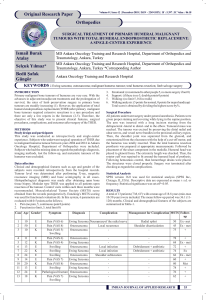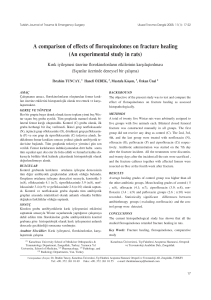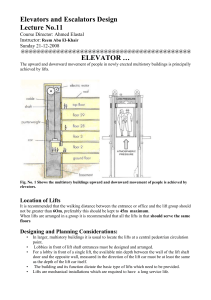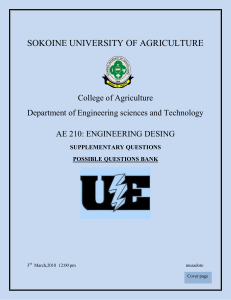Uploaded by
common.user2111
Assessment of Surgical Treatment and Long-Term Follow-up Results of Extremity Liposarcomas: A Single Center Experience
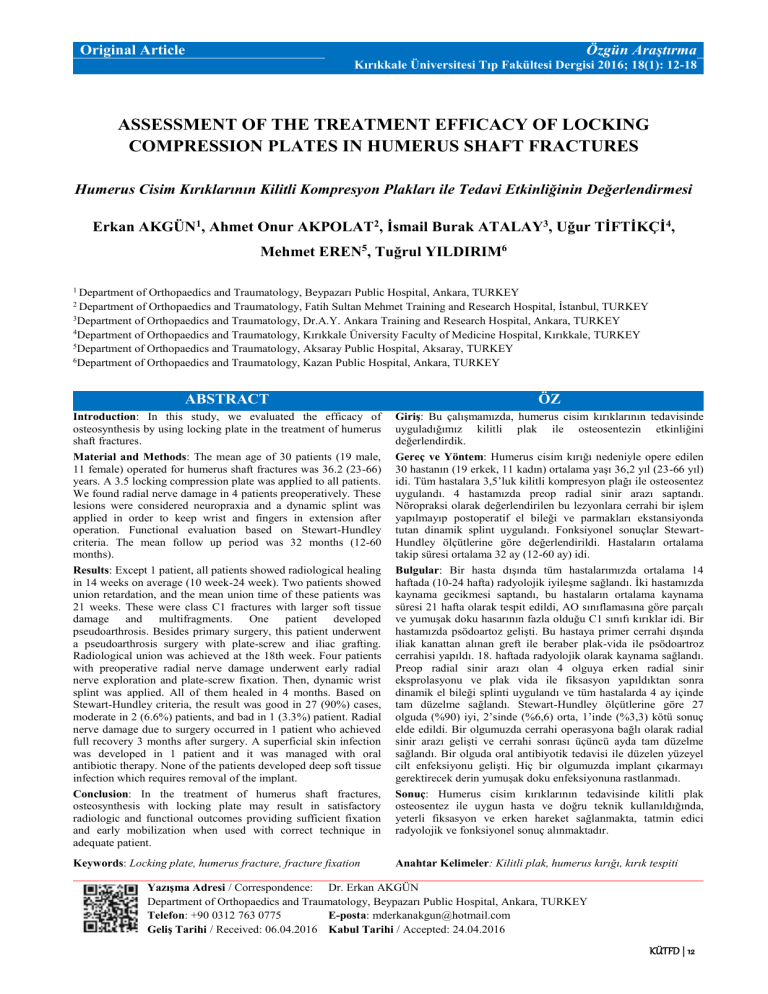
Özgün Araştırma Original Article Kırıkkale Üniversitesi Tıp Fakültesi Dergisi 2016; 18(1): 12-18 ASSESSMENT OF THE TREATMENT EFFICACY OF LOCKING COMPRESSION PLATES IN HUMERUS SHAFT FRACTURES Humerus Cisim Kırıklarının Kilitli Kompresyon Plakları ile Tedavi Etkinliğinin Değerlendirmesi Erkan AKGÜN1, Ahmet Onur AKPOLAT2, İsmail Burak ATALAY3, Uğur TİFTİKÇİ4, Mehmet EREN5, Tuğrul YILDIRIM6 of Orthopaedics and Traumatology, Beypazarı Public Hospital, Ankara, TURKEY of Orthopaedics and Traumatology, Fatih Sultan Mehmet Training and Research Hospital, İstanbul, TURKEY 3Department of Orthopaedics and Traumatology, Dr.A.Y. Ankara Training and Research Hospital, Ankara, TURKEY 4Department of Orthopaedics and Traumatology, Kırıkkale Üniversity Faculty of Medicine Hospital, Kırıkkale, TURKEY 5Department of Orthopaedics and Traumatology, Aksaray Public Hospital, Aksaray, TURKEY 6Department of Orthopaedics and Traumatology, Kazan Public Hospital, Ankara, TURKEY 1 Department 2 Department ABSTRACT ÖZ Introduction: In this study, we evaluated the efficacy of osteosynthesis by using locking plate in the treatment of humerus shaft fractures. Material and Methods: The mean age of 30 patients (19 male, 11 female) operated for humerus shaft fractures was 36.2 (23-66) years. A 3.5 locking compression plate was applied to all patients. We found radial nerve damage in 4 patients preoperatively. These lesions were considered neuropraxia and a dynamic splint was applied in order to keep wrist and fingers in extension after operation. Functional evaluation based on Stewart-Hundley criteria. The mean follow up period was 32 months (12-60 months). Results: Except 1 patient, all patients showed radiological healing in 14 weeks on average (10 week-24 week). Two patients showed union retardation, and the mean union time of these patients was 21 weeks. These were class C1 fractures with larger soft tissue damage and multifragments. One patient developed pseudoarthrosis. Besides primary surgery, this patient underwent a pseudoarthrosis surgery with plate-screw and iliac grafting. Radiological union was achieved at the 18th week. Four patients with preoperative radial nerve damage underwent early radial nerve exploration and plate-screw fixation. Then, dynamic wrist splint was applied. All of them healed in 4 months. Based on Stewart-Hundley criteria, the result was good in 27 (90%) cases, moderate in 2 (6.6%) patients, and bad in 1 (3.3%) patient. Radial nerve damage due to surgery occurred in 1 patient who achieved full recovery 3 months after surgery. A superficial skin infection was developed in 1 patient and it was managed with oral antibiotic therapy. None of the patients developed deep soft tissue infection which requires removal of the implant. Conclusion: In the treatment of humerus shaft fractures, osteosynthesis with locking plate may result in satisfactory radiologic and functional outcomes providing sufficient fixation and early mobilization when used with correct technique in adequate patient. Giriş: Bu çalışmamızda, humerus cisim kırıklarının tedavisinde uyguladığımız kilitli plak ile osteosentezin etkinliğini değerlendirdik. Gereç ve Yöntem: Humerus cisim kırığı nedeniyle opere edilen 30 hastanın (19 erkek, 11 kadın) ortalama yaşı 36,2 yıl (23-66 yıl) idi. Tüm hastalara 3,5’luk kilitli kompresyon plağı ile osteosentez uygulandı. 4 hastamızda preop radial sinir arazı saptandı. Nöropraksi olarak değerlendirilen bu lezyonlara cerrahi bir işlem yapılmayıp postoperatif el bileği ve parmakları ekstansiyonda tutan dinamik splint uygulandı. Fonksiyonel sonuçlar StewartHundley ölçütlerine göre değerlendirildi. Hastaların ortalama takip süresi ortalama 32 ay (12-60 ay) idi. Bulgular: Bir hasta dışında tüm hastalarımızda ortalama 14 haftada (10-24 hafta) radyolojik iyileşme sağlandı. İki hastamızda kaynama gecikmesi saptandı, bu hastaların ortalama kaynama süresi 21 hafta olarak tespit edildi, AO sınıflamasına göre parçalı ve yumuşak doku hasarının fazla olduğu C1 sınıfı kırıklar idi. Bir hastamızda psödoartoz gelişti. Bu hastaya primer cerrahi dışında iliak kanattan alınan greft ile beraber plak-vida ile psödoartroz cerrahisi yapıldı. 18. haftada radyolojik olarak kaynama sağlandı. Preop radial sinir arazı olan 4 olguya erken radial sinir eksprolasyonu ve plak vida ile fiksasyon yapıldıktan sonra dinamik el bileği splinti uygulandı ve tüm hastalarda 4 ay içinde tam düzelme sağlandı. Stewart-Hundley ölçütlerine göre 27 olguda (%90) iyi, 2’sinde (%6,6) orta, 1’inde (%3,3) kötü sonuç elde edildi. Bir olgumuzda cerrahi operasyona bağlı olarak radial sinir arazı gelişti ve cerrahi sonrası üçüncü ayda tam düzelme sağlandı. Bir olguda oral antibiyotik tedavisi ile düzelen yüzeyel cilt enfeksiyonu gelişti. Hiç bir olgumuzda implant çıkarmayı gerektirecek derin yumuşak doku enfeksiyonuna rastlanmadı. Sonuç: Humerus cisim kırıklarının tedavisinde kilitli plak osteosentez ile uygun hasta ve doğru teknik kullanıldığında, yeterli fiksasyon ve erken hareket sağlanmakta, tatmin edici radyolojik ve fonksiyonel sonuç alınmaktadır. Keywords: Locking plate, humerus fracture, fracture fixation Anahtar Kelimeler: Kilitli plak, humerus kırığı, kırık tespiti Yazışma Adresi / Correspondence: Dr. Erkan AKGÜN Department of Orthopaedics and Traumatology, Beypazarı Public Hospital, Ankara, TURKEY Telefon: +90 0312 763 0775 E-posta: [email protected] Geliş Tarihi / Received: 06.04.2016 Kabul Tarihi / Accepted: 24.04.2016 KÜTFD | 12 Akgün E and et al. Humerus Shaft Fractures Locking Compression Plates KÜ Tıp Fak Derg 2016; 18(1): 12-18 INTRODUCTION PATIENTS AND METHOD Humerus shaft fractures account for 3% to 5% of all Thirty patients (19 male, 11 female) who were operated fractures (1, 2). Those fractures, in general, result from due to humerus diaphyseal fracture between February axial compression, bending or torsional forces. The 2005 and June 2009 were included to the study. The treatment should be effective against these forces (3). mean age was 36.2 (23-66) years. In the fixation of Various treatment methods were defined in humeral humerus diaphysis fractures. Among these, conservative and compression AO plates were used. The included surgical methods can be listed. Today, conservative fractures were between 5 cm distal to surgical neck and method with a functional brace has been the most 5 cm proximal to olecranon fossa. Patients under 18 common method for treatment of humerus shaft years of age, patients with pathological fracture, and fractures. However, there are some disadvantages such patients who had pseudoarthrosis treatment were as the risk of non-union, frequent night pains, excluded. limitation of self-care, long-term use in some cases. The fracture was on the right side in 18 (60%) patients Despite the and on the left side in 12 (40%) patients. The reason conservative method is still popular due to success was motor vehicle traffic collision in most of the cases. rates higher than 90% (4). Surgery is inevitable for a Twelve patients (40%) were in the car whereas 8 good functional outcome in humerus fractures resulting (26.6%) were out of the car. Other reasons included from high energy trauma. In addition, surgery should falls in 7 (23.3%) patients and workplace accidents in 3 be the first choice in open fractures, pathological (10%) patients. According to Gustillo – Anderson fractures, bilateral humeral fractures, ipsilateral multi- classification, 3 (10%) patients had Type 1 and 1 site upper extremity fractures, in polytrauma patients, (3.3%) patient had Type 2 open fracture. According to in patients with humerus diaphysis fractures together AO/ASIF classification, 3 (10%) patients had A1, 6 with thoracic or head trauma, and in patients with (20%) patients had A2, 13 (43.3%) patients had A3, 2 vessel injury (5-7). Postoperative complications such as (6.6%) patients had B1, 1 (3.3%) patient had B2, 2 infection, (6.6%) patients had B3, and 3 (10%) patients had C1 all these disadvantageous non-union, radial nerve factors, injury have orthopedic surgeon to choose conservative treatment (5). The most important drawback in conservative treatment is limitation in mobility of elbow and shoulder joints due to immobilization. Today, Sarmiento brace enables early mobilization and protects joint range of motion. In surgery, the most common fixation materials are plate screw, elastic shaft fractures, number 3.5 locking fracture. 4 (13.3%) patients had 1/3 proximal, 21 (70%) patients had 1/3 middle, and 5 (16.6%) patients had 1/3 distal fracture localization. When the fracture line is taken into account, 13 (43.3%) transverse, 6 (20%) oblique, 8 (26.6%) spiral and 3 (10%) multifragmentary fracture were determined. intramedullary nail, locking intramedullary nail and external fixators (6, 7). However, superiority of each material to others is controversial and there has been no ideal fixation method yet. Four (13.3%) of the patients had preoperative radial nerve damage. These patients had dynamic wrist splint which kept wrist and fingers in extension. None of the patients had vessel injury related with fracture. In this study, radiologic, clinical and functional outcomes of 30 patients treated with locking related complications were also recorded. All of the 30 patients underwent open reduction and fixation by using 3.5 nr titanium locking compression AO plates. Of these, 7 (23.3%) patients had KÜTFD | 13 Akgün E and et al. Humerus Shaft Fractures Locking Compression Plates conservative treatment which failed to KÜ Tıp Fak Derg 2016; 18(1): 12-18 provide removal of sutures. All patients received first sufficient reduction or resulted in loss of reduction generation cephalosporin (3x1 g/day) for 5 days. On during follow up period. Another common indication the postoperative 15th day, passive movements of for surgery was surgery for other reasons and early hand, wrist, elbow and shoulder were started. Active mobilization in 7 (23.3%) patients. elbow and shoulder movements until pain threshold Surgical incision was anterolateral in all patients. were started. Patients were followed up by monthly x- Plates had at least 6 holes and maximum 10 holes. ray imaging. Minimum 6 cortical screws were placed to proximal The mean follow up period was 32 (range, 12-60) and distal parts of the fracture line. Long arm splint months. Radiological and functional evaluations were was applied to reduce postoperative movement-related performed during follow up period. Steward-Hundley pain and fixation was ended on the 15th day after criteria were used for functional evaluation (Table 1). Table 1. Functional evaluation based on Steward-Hundley criteria Result Pain Limitation of elbow and shoulder motion Angulations Good None <20º <10º Moderate following fatigue or an effort 20º-40º >10º Bad Continuous >40º Radiologic non-union RESULTS Thirty patients who had osteosynthesis with platescrew were included. The mean follow up period was 32 (12-60) months. Union time, shoulder and elbow joint functions, and postoperative complications were evaluated. Steward-Hundley criteria were used for functional evaluation. Accordingly, 1 patient had shoulder These 2 patients had C1 fracture of AO classification which includes extensive soft tissue damage and multifragmentation. One patient developed pseudoarthrosis and had revision and grafting with iliac wing corticospongios bone and plate-screw. Radiologic healing was obtained in 18 weeks. One patient had superficial skin infection and cured by oral antibiotic therapy. None of the patients developed movement limitation less than 20°, other 2 patients had deep soft tissue infection and osteomyelitis. None of elbow joint movement limitation between 20º-40º. In the patients had scarring which required revision. one of these patients, external fixation was used in Four patients (13.3%) had preoperative radial nerve addition to long-term internal fixation because of injury. These patients underwent early radial nerve fixation safety. Another patient started physical therapy exploration together with locking plate-screw fixation. program later due to retardation of union. None of the None of the patients showed radial nerve cut and the patients showed angular deformity higher than 10º, and lesions were accepted as neuropraxia. Postoperative shortness more than 1 cm. dynamic wrist splint was applied in order to keep The mean fracture union time was 14 (10-24) weeks. Two patients showed retarded union and the mean fracture union time was 21 weeks in these two patients. extension position of the wrist. All of the patients achieved full recovery in 4 months. Besides those 4 patients, 1 (3.3%) patient developed iatrogenic radial KÜTFD | 14 Akgün E and et al. Humerus Shaft Fractures Locking Compression Plates KÜ Tıp Fak Derg 2016; 18(1): 12-18 nerve injury due to operation and this patient was of radial nerve injury after injury, and complications followed up by dynamic wrist splint and achieved full such as pseudoarthrosis, and infection made the recovery in 3 months. conservative treatment the first line of the treatment (8, The mean recovery time in our patients other than the 10, 14). patient with osteoarthrosis was 14 (10-24) weeks. In 2000, Sarmiento et al., published a study of 620 Based functional diaphyseal humerus fractures treated by functional outcome was good in 27 (90%) patients, moderate in 2 brace. They found 3% nonunion and the mean fracture (6.6%) patients and bad in 1 (3.3%) patient. union time was 11.5 weeks. They also stated that on Steward-Hundley criteria, conservative treatment was cheaper than surgical treatment and it does not require hospitalization (15). DISCUSSION In 1988, Zagorski et al., performed conservative Diaphyseal humerus fractures account for 3% to 5% of treatment in 170 humerus shaft fractures and 3 patients all fractures (1, 2). The most common mechanism for developed nonunion. The mean angle was 5º (12). In injury is blow directly to arm and especially motor literature, vehicle collision. Another factor is to fall down (2, 8). treatment were reported by McMaster (elbow hinged In our series, the reason was motor vehicle collision in cast brace), Winfield (using hanging cast), and 20 patients (66.6%). The second reason was falls in 7 Clenermann (using U splint) (16, 17). Steward and (23.3%) patients. The reason for diaphyseal humerus Hundley used U splint and reported the mean union fractures in young people is mostly high energy trauma time to be 10 weeks. The Union rate was 94% (17, 18). whereas it may be simple falls in osteoporotic elderly We also use conservative treatment in humerus shaft after 7th decade (9). Among our 30 patients, 20 fractures as the primary treatment. (66.6%) were between 18 to 40 years of age. Conservative treatment can be performed in many Diaphyseal humerus fractures do not show gender cases. However, surgery is necessary in patients with tendency. The left arm is affected more than the other extensive soft tissue damage, multiple trauma, in side (10). In this study, of the patients, 63.3% were patients with loss of reduction or irreducible fracture, male whereas 36.6% were female. The fracture was on non-union and pathological fractures (5). In addition, the right in 18 (60%) patients and on the left in 12 surgery should be preferred in patients with vascular (40%) injury, patients. Literature suggest that middle successful radial nerve results injury with after conservative reduction, diaphyseal region is involved more than the others and multifragmentary fractures, or floating elbow (7, 19). the fracture line is mostly transverse (11, 12). Our Of the studied 30 patients, 7 were (23, 3%) initially study group was in accordance with literature. Of the treated with conservative methods. But, during control fractures, 70% was in the middle 1/3 and 43.3% was visits, loss of reduction, extensive distraction, and transverse. insufficient patient compliance led to surgery. Most of The most commonly preferred treatment method for the fractures were transverse. Although conservative diaphyseal conservative. treatment is recommended in transverse fractures, Conservative treatment methods include functional surgery should be considered when the patient is brace, U splint and hanging cast. U splint and incompliant or in distraction of fracture line due to functional brace are preferred especially in mid- heavy casting. According to Klenerman, primary diaphyseal surgical humerus fractures spiral-oblique is fractures (13). Besides successful results with conservative treatment, the risk treatment in mid-diaphyseal transverse fractures may increase the risk of non-union (17, 20). KÜTFD | 15 Akgün E and et al. Humerus Shaft Fractures Locking Compression Plates KÜ Tıp Fak Derg 2016; 18(1): 12-18 In this study, among the surgery indications, the first screws, the bond between screw head and hole is line was loss of position following a conservative designed grooved in order to provide angular stability treatment in 7 (23.3%) patients. Other reasons include and contact of bone and implant. These plates affect multitrauma, intolerance to conservative treatment and biology of periosteum lesser than LC-DCP plates and failure of reduction and retardation of bone union. apply lesser pressure onto the bone. As the screw is Osteosynthesis with plate-screw, intramedullary nail locked to plate, it leads lesser bone necrosis and and external fixator are used in surgical treatment (4, 5, periosteum 21, 22). External fixator is preferred in open fractures. conventional screw hole, axial compression is possible Disadvantages consist of lesser patient comfort, pin on the fracture line (3, 22, 27-29). None of our patients bottom infections, failure to provide rigid fixation and showed nonunion due to implant failure. nonunion (10). Fine fixation of osteoporotic bone is difficult. The Intramedullary nailing technique has advantages of holding power of screw is positively correlated with minimal and bone mineral density (27, 29, 30). Two (6.6%) of the disadvantages of shoulder movement limitation, rotator patients were above 65 years of age and their mean cuff lesions and nonunion due to rotational stability union time was 5 months. These patients mobilized in loss. The rate of non-union was reported 22% by Flink early period and no implant failure was observed. et al., 23% by Robinson et al., 13% by Stern et al. On Therefore, we think that osteosynthesis with locking the other hand, Riemer et al., reported union in all their plate is a good internal fixation material in osteoporotic patients (22-25). Intramedullary nailing in the right humerus shaft fractures. indication with flawless technique may significantly Iatrogenic radial nerve injury can be seen at the rate of reduce the rate of non-union (4, 7, 21). 3-29% in plate-screw osteosynthesis of diaphyseal Bell achieved bone union in 33 of 34 polytrauma humerus fractures (12, 17). This rate is between 0-3% patients with an average 19 weeks (26). Foster in intramedullary nailing (4, 21). In our study, only 1 achieved bone union in 91% of the patients by using patient (3.3%) had postoperative radial nerve lesion. compression plate (5). Kesemenli et al. found 97% There was no sensory deficit but motor deficit union rate in 3.5 months in 27 patients by using locking developed. Extensor dynamic wrist splint was used and plate (21). In our study, radiologic recovery was full recovery was achieved in 3 months. We think that achieved in 14 (10-24) weeks in 29 of 30 patients radial nerve injury was due to excess traction or (96.6%) with 3.5 nr locking plate. One patient neuropraxia during release. Persistent nerve injury due developed pseudoarthrosis, and underwent grafting and to total radial nerve rupture was observed in none of a second fixation with locking plate. He achieved the patients. radiologic union in 18th week. Conservative treatment is still the first choice in In classical plate-screw osteosynthesis, the stability of diaphyseal humerus fractures in selected patients. fracture fixation is directly related with friction However, when conservative treatment is no possible, between the bone surface and screw hold. Stability is locking compression plates can be applied according to related with holding resistance of cortical screws to fundamental AO rules. These plates should be screwed cortical bone. Bending resistance of screws and distal and proximal ends of the fracture passing at least prevention of movement between plate and screw seem 6 cortices. Besides, we think that surgery with to increase stability. In locking compression plate- minimum soft tissue and radial nerve damage is an incision and close fracture line corruption. As these plates have effective and safe treatment method. KÜTFD | 16 Akgün E and et al. Humerus Shaft Fractures Locking Compression Plates KÜ Tıp Fak Derg 2016; 18(1): 12-18 Disclosure of interest: The authors declare that they 9. Tytherleigh-Strong G, Walls N, McQueen MM. have no conflicts of interest concerning this article. The epidemiology of humeral shaft fractures. J Bone Joint Surg Br. 1998; 80(2): 249-53. 10. Caldwell JA. Treatment of Fractures in the REFERENCES Cincinnati General Hospital. Ann Surg. 1933; 1. Nayak NK, Schickendantz MS, Regan WD, Hawkins RJ. Operative treatment of nonunion of surgical neck fractures of the humerus. Clin Orthop Relat Res. 1995; 313: 200-5. Törnkvist H, Ponzer S. Fractures of the shaft of the An epidemiological 11. Charles A, Rockwood Jr, David PG, Robert WB, James DH. Rockwood and Green’s Fractures in Adults. Lippincott-Raven. 1996. 2. Ekholm R, Adami J, Tidermark J, Hansson K, humerus. 97(2): 161-76. study of 401 fractures. J Bone Joint Surg Br. 2006; 88(11): 1469- 12. Zagorski JB, Latta LL, Zych GA, Finnieston AR. Diaphyseal fractures of the humerus. Treatment with prefabricated braces. J Bone Joint Surg Am. 1988; 70(4): 607-10. 73. 13. Seligson D, Ostermann PA, Henry SL, Wolley T. 3. Modabber MR, Jupiter JB. Operative management of diaphyseal fractures of the humerus. Plate versus nail. Clin Orthop Relat Res. 1998; 347: 93-104. 4. Arpacioğlu MO, Pehlivan O, Akmaz I, Kiral A, Oğuz Y. Interlocking intramedullary nailing of humeral shaft fractures in adults. Acta Orthop Traumatol Turc. 2003; 37(1): 19-25. 5. Foster RJ, Dixon GL Jr, Bach AW, Appleyard RW, Green TM. Internal fixation of fractures and nonunions of the humeral shaft. Indications and results in a multi-center study. J Bone Joint Surg Am. 1985; 67(6): 857-64. 6. Sarmiento A, Waddell JP, Latta LL. Diaphyseal humeral fractures: treatment options. Instr Course Lect. 2002; 51: 257-69. 7. Öztürk K, Aksoy B, Okay E, Yıldırım ÖS, Esenyel ES, Kara AN. Humerus cisim kırıklarının plak vida The management of open fractures associated with arterial injury requiring vascular repair. J Trauma. 1994; 37(6): 938-40. 14. Shao YC, Harwood P, Grotz MR, Limb D, Giannoudis PV. Radial nevre palsy associated with fractures of the shaft of the humerus: a systematic review. J Bone Joint Surg Br. 2005; 87(12): 164752. 15. Sarmiento A, Zagorski JB, Zych GA, Latta LL, Capps CA. Functional bracing for the treatment of fractures of the humeral diaphysis. J Bone Joint Surg Am. 2000; 82(4): 478-86. 16. Hunter SG. The closed treatment of fractures of the humeral shaft. Clin Orthop Relat Res. 1982; 164: 192-8. 17. L. Klenerman. Fractures of the shaft of the humerus. J Bone Joint Surg Am. 1990; 72: 701-7. osteosentezi ile tedavisi. Acta Orthop Traumatol Turc. 1999; 33: 121-5. 8. Dağlar B, Delialioğlu OM, Taşpaş BA, Bayrakçi K, Ağar M, Günel U. Comparison of plate-screw fixation and intramedullary fixation with inflatable nails in the treatment of acute humeral shaft fractures. Acta Orthop Traumatol Turc. 2007; 41(1): 7-14. 18. Christensen S. Humeral shaft fractures, operative and conservative treatment. Acta Chir Scand. 1967; 133(6): 455-60. 19. Böstman O, Bakalim G, Vainionpaa S, Wilppula E, Patiala H, Rokkanen P. Radial palsy in shaft fracture of the humerus. Acta Orthop Scand. 1986; 57(4): 316-9. KÜTFD | 17 Akgün E and et al. Humerus Shaft Fractures Locking Compression Plates 20. Kettelkamp DB, Alexander H. Clinical review of KÜ Tıp Fak Derg 2016; 18(1): 12-18 29. Aksu N, Göğüş A, Kara AN, Işiklar ZU. radial nerve injury. J Trauma 1967; 7(3):424–32. Complications encountered in proximal humerus 21. Kesemenli CC, Subaşi M, Arslan H, Necmioğlu S, fractures treated with locking plate fixation. Acta Kapukaya A. Comparison between the results of Orthop Traumatol Turc. 2010; 44(2): 89-96. intramedullary nailing and compression plate 30. Will R, Englund R, Lubahn J, Cooney TE. Locking fixation in the treatment of humerus fractures. Acta plates have increased torsional stiffness compared Orthop Traumatol Turc 2003; 37(2): 120-5. to standard plates in a segmental defect model of 22. Flinkkila T, Hyvönen P, Lakovaara M, Linden T, Ristiniemi J, Hamalainen M. Intramedullary nailing clavicle fracture. Arch Orthop Trauma Surg. 2011; 131(6): 841-7. of humeral shaft fractures. A retrospective study of 126 cases. Acta Orthop Scand 1999; 70(2): 133-6. 23. Robinson CM, Bell KM, Court-Brown CM, McQueen MM. Locked nailing of humeral shaft fractures. Experience in Edinburgh over a two-year period. J Bone Joint Surg Br. 1992; 74(4): 558-62. 24. Stern PJ, Mattingly DA, Pomeroy DL, Zenni EJ Jr, Kreig JK. Intramedullary fixation of humeral shaft fractures. J Bone Joint Surg Am. 1984; 66(5): 63946. 25. Riemer BL, Butterfield SL, D'Ambrosia R, and Kellam J. Seidel intramedullary nailing of humeral diaphyseal fractures: a preliminary report. Orthopedics. 1991; 14(3): 239-46. 26. Bell MJ, Beauchamp CG, Kellam JK, McMurtry RY. The results of plating humeral shaft fractures in patient with multiple injuries. The Sunnybrook experience. J Bone Joint Surg Br. 1985; 67(2): 2936. 27. H Bekler, Bulut G, Usta M, Gökçe A, Okyar F, Beyzadeoğlu T. The contribution of locked screwplate fixation with varying angle configurations to stability of osteoporotic fractures: an experimental study. Acta Orthop Traumatol Turc. 2008; 42(2): 125-9. 28. Jiang R, Luo CF, Zeng BF, Mei GH. Minimally invasive plating for complex humeral shaft fractures. Arch Orthop Trauma Surg. 2007; 127(7): 531-5. KÜTFD | 18
